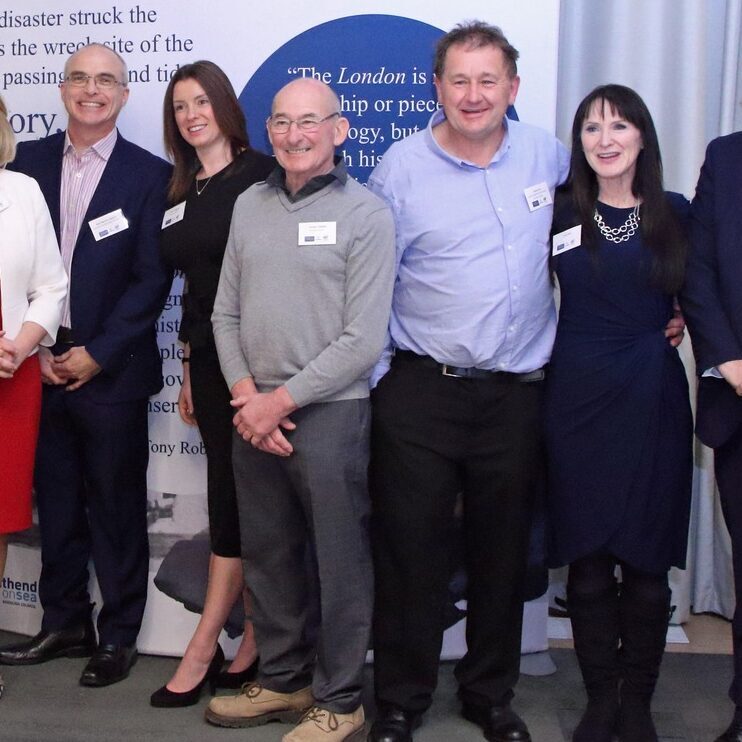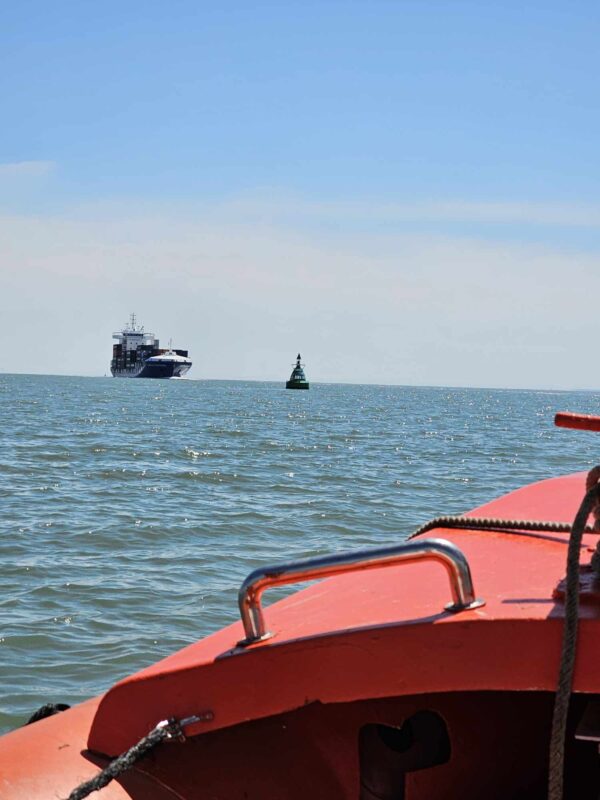Exciting Discovery
Now, at last we can reveal our latest find on the London shipwreck which we are so excited to share.
After monitoring and surveying the protected wreck site of the London for over thirteen years, we found one of the London’s bronze cannons which has become exposed after being entrapped by the thick Thames clay and sediment for over 350 years.
With the help of our on-board ordnance specialist friends Charles Trollop, Richard Endsor and the late Frank Fox, we believe it is a rare Commonwealth, eight and a half foot long, demi-cannon, cast by George Browne, between 1656-1657, as part of a set commissioned for the London and possibly also for the Dunbar.

During the period between 2005 -2010, limited dive investigations were carried out by the Port of London Authority (PLA) and Wessex Archaeology as part of the DP World Gateway Port development project. Being so limited in their scope these investigations left so much more for us to examine and to try to work out of what was still left of the wreckage of the ship in the Thames Estuary. And so began a fantastic project and immense challenge for us.


It all started in 2010, as a small group of regular Thames Estuary divers, interested in maritime history who were invited by Historic England to become the protected wreck licensees for the London to try and solve this great historical underwater puzzle, which lays in the murky depths of the Thames Estuary, helped by formulating of a detailed site plan.
We observed many artefacts emerging and being washed away, alongside smaller fragments of the ship’s structure due to the constant shipping activity, which had affected this site and continues at a rapid pace to this present day. After many dives, the team started to have a better understanding of the site, and a small test pit was requested to prove the team’s theory regarding the location of the vessel’s main gun deck, which was still laying beneath the sediment.

This led us, as the wreck licensees to be partly sponsored to become commercial divers, enabling us to work alongside a team of professional archaeologists on a Historic England funded excavation project between 2014 and 2016.
It was great that the licensed team members, were excavating in the test pit area, where not only the main gun deck was discovered, but also a rare complete gun carriage was found too. This was brilliant as it confirmed our theory and gave us a greater picture of what remains of the vessel still buried beneath the Thames silt. With this newly gained knowledge the volunteer divers discovered another gun carriage during a dive a few weeks later.

OK, some people might say well this is easy enough job to do, but please remember this is no ordinary English wreck site, as the Thames Estuary has strong currents, zero visibility and sits in one of the world’s busiest shipping lanes. But, we couldn’t ask for better support from the Port of London Authority, who request the shipping to ease down whilst out on our dives.
It is so exciting to come across artefacts like this bronze cannon where they are expected to be after working it out from many hours of investigation, surveying and mapping the site, trying to get to know the internal layout as it continues to erode out of the silt.
Expert and huge supporter, Charles Trollop mentioned that it would only be a matter of time before we came across one and according to Frank L Fox’s document, The London of 1656: Her History and Armament, “there’s still should be thirty-five brass guns still awaiting discovery” (and of course minus one now).
At the time of writing, we are still waiting for a decision from Historic England to whether it should be recovered.
Special thanks to Alison James of MSDS Marine who has assisted in providing the team with the protective marking material, to be applied to the site. Also, the team has recorded the cannon’s unique features for extra security measures and due to the site’s location the site is under the constant surveillance of the Port of London’s Vessel Traffic Service.

The Future
Since 2019 we have been supported by the Nautical Archaeology Society and the Save The London Campaign, with their CEO, Mark Beattie-Edwards becoming our Nominated Archaeologist. Over the last few years with Mark’s help has been building relationships with stakeholders like Southend City Council, Southend Museum, local politicians, the Port of London and DP World – all of which have expressed their support for our efforts.
Our dream would be for the cannon to be excavated and recovered for curation by Southend Museum Services. But of course, that has a cost associated with it – the cost of recovery and the cost of conservation. For this to happen, the next steps must be to devise a Baldrick like “cunning plan” and to approach supporters for the funds.
We would love to hear from you if you think you can help support this effort.

It would be amazing for the cannon to be on display in Southend Museum. The number of visitors they receive yearly can only help to promote awareness and gather support for the investigation of the “at-risk” site. We believe it would be shame for the cannon to remain on the seabed, or just to be kept in museum stores, it must be displayed and maybe even go on loan and on tour so that many more people can see it and learn about the London tragedy in 1665.
Although the cannon will not be washed away, like so many other artefacts we have seen, we do ponder as to why should we be the only ones to see these wonderful artefacts laying on the bottom of the Thames. Shouldn’t everyone be able to see them? After all it is their heritage and their past, as much as it is ours.
